Bovine Lameness and Podiatry
Foot Rot
G Cramer
What is it
Foot rot is usually a sporadic infection of the soft tissues of the foot in dairy and beef cattle. Foot rot lameness can range from mild to severe and usually has a sudden onset.
How to recognize it
Foot rot is recognized by the sudden onset of lameness accompanied by the symmetrical swelling of the lower leg above the digits. Swelling above the coronary band that affects both digits and includes the interdigital space is almost pathognomonic for foot rot. [Hoof horn issues will typically only affect one digit and the swelling will be asymmetrical.]
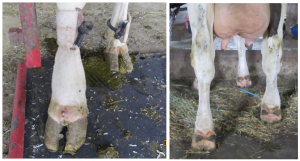
Depending on the stage of the disease the interdigital skin splits open and putrid, foul-smelling discharge is noticeable.
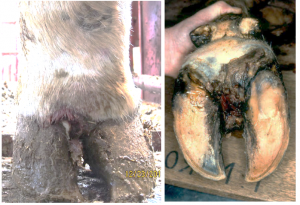
In more severe cases, loose pieces of necrotic tissue can be easily removed from the interdigital space.
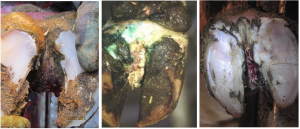
Pathogenesis
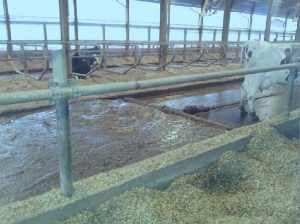
The most common bacteria associated with foot rot are Fusobacterium necrophorum subspecies necrophorum, Dichelobacter nodosus, Trueperella pyogenes, Porphyromonas levii and Prevotella intermedia. The bacteria are all gram negative anaerobes that are present in the GI system of cattle and thus their environment. A defect in the interdigital skin allows opportunistic invasion by these bacteria. The bacteria then work synergistically to cause inflammation and necrosis of the soft tissues in the lower leg. In severe cases the infection can spread to tendons/flexor tendon sheath and/or the distal joints resulting in a very severe lameness.
How to prevent it
The key focus for preventing foot rot is preventing skin damage. Skin damage typically occurs due to things such as rocks, sharp edges, and cables in the animals environment. Skin damage can also occur due chronic wetting of the foot in muddy or wet and dirty environments.

On dairy farms, footbaths with a range of disinfectants are used to clean and disinfect the interdigital skin.
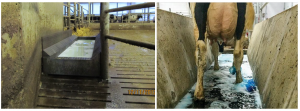
Currently, there are no pharmaceutical products labelled with a claim to prevent foot rot.
How to treat it
Foot rot should be treated with systemic antibiotics according to label directions. This is the only foot condition that is typically treated with systemic antibiotics! There are several drugs specifically labeled for foot rot. These include LA 200®(oxytetracycline), Naxcel® (ceftiofur), Excenel®RTU (ceftiofur), and Draxxin® (tulathromycin).
There is typically no need to remove necrotic tissue or apply bandages. Treated animals should visually improve with 2-3 days. If animals do not respond, the diagnosis should be re-evaluated. Animals with ascending infection will not respond well to standard antibiotic therapy and will require drainage of infected joints or tendon sheaths (or should be culled).
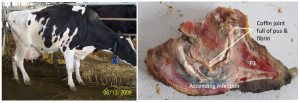
Key Takeaways
If the swelling above the foot is symmetrical, think foot rot! If it just above one digit, think hoof horn issues.
Foot rot causes lower limb swelling, smelly feet and lameness. It occurs due to opportunistic infection of wet traumatized feet by gram negative anaerobes. Systemic antibiotics are used for treatment. Ascending infection can develop and lead to coffin joint or flexor tendon sheath infections.
Footbaths are useful to prevent bacterial infections – foot rot and digital dermatitis.
Foot rot is treated with systemic antibiotics.
Resources
Lameness originating in the hoof of cattle, Cramer and Solano, merckvetmanual.com
Implications for lameness control in cattle -Vet Clin Food Anim 41 (2025) 395–406
Foot rot slide share – great hints on detecting swelling

